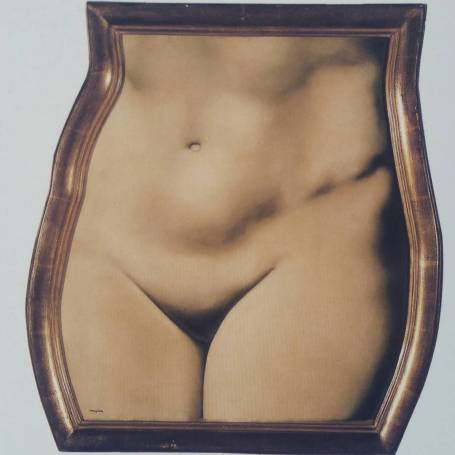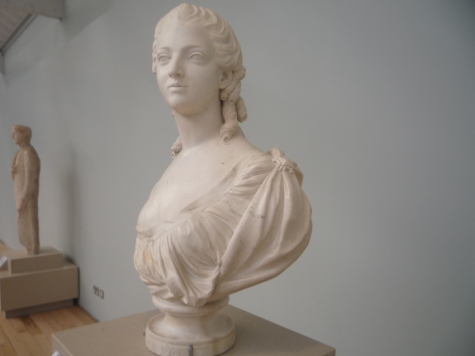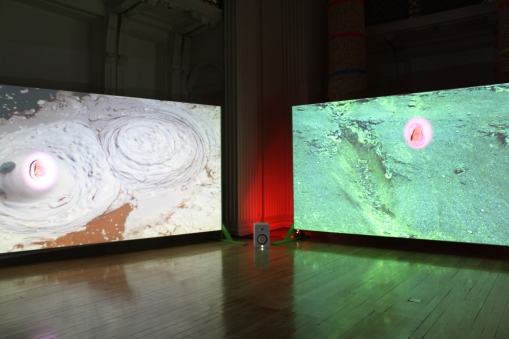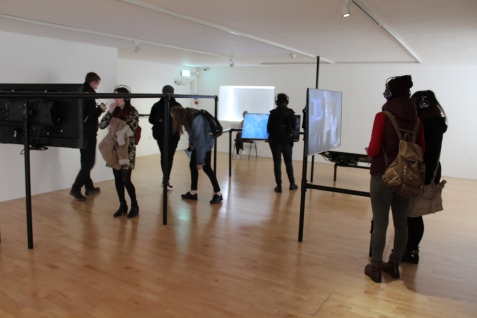
Installation shot including various works by Salvador Dali
“Everything tends to make us believe that there exists a certain point of the mind at which life and death, the real and the imagined, past and future, the communicable and the incommunicable, high and low, cease to be perceived as contradictions.”
– André Breton, Manifesto of Surrealism
Recently I visited the Scottish National Gallery of Modern Art on what I thought would be a brief afternoon excursion. Almost four hours later I emerged from’Surreal Encounters: Collecting The Marvelous’ enlightened and inspired. Marvelous; there could not be a more apt word to apply to this broad collection of artworks. Immediately upon entry you are greeted by renowned and famous names including Picasso, Man Ray and Duchamp. Seeing a collection of those artists merely in the corridor – before I’d even entered a room – made me realise the sheer stature of this exhibition. This was and is quite the collection of Surrealist works. Never before have I seen so many Dali and Magritte pieces clustered in such close proximity. The result was mesmerizing. I felt like Alice in Wonderland tumbling down the rabbit hole into a world of dreams, blue endless skies, obscure depictions and dripping, blurring creatures. For someone who has read countless books on Dada and Surrealism, two art movements that changed and shaped the course of art history, it was like walking into a shrine dedicated to works of the past. I couldn’t quite believe what I was seeing.

Installation shot hosting the works of René Magritte
The exhibition was beautifully curated and very insightful in terms of how the collections came about. As a viewer you are given an in depth account of how Roland Penrose, Edward James, Gabrielle Keiller and Ulla and Heiner Pietzsch came to acquire the works. This was done through a series of conducted interviews. I thought this was a very effective component of the exhibition as in among all of these monumental and historical works by Miro and Magritte, there were TV screens with the interviews being played out. With the giggles between partners Ulla and Heiner Pietzsch echoing throughout the space as they discussed their plans for their collections, I couldn’t help but feel that their stories brought the collections and the artwork even more to life. As a viewer, not only were you busy plummeting into a whimsical world within the frame and trying to decipher and make sense of something so non-nonsensical, but you also became aware of how it came to be hung on the wall in front of you. The care and thought that went into the collections and the articulate eye required to amount such works, was extraordinary. It was fascinating hearing how Gabrielle Keiller had realised Duchamp’s artistic potential and decided to gather his works. Of course it was equally fascinating seeing the works themselves; Duchamp’s mini replication of ‘The Bride Stripped Bare By Her Bachelors‘ was rather mesmerising in itself.

‘Female Fig Leaf’, Marcel Duchamp, 1961
Marcel Duchamp is an artists I have studied very closely, so for me seeing his work was kind of like seeing a celebrity on the red carpet. His concept of the Readymade turned the art world upside down when he declared a urinal a work of art. A Readymade is a work that consists of objects that were, believe it or not, ready made. They become an artwork essentially through the declaration of the artist. This of course caused outrage in the artworld at the time and Duchamp’s urinal, or ‘Fountain‘ as he named it, was in fact refused entry to the Parisian Salon des Indépendants. At the time it was revolutionary and outrageous, now this act and the creation of the readymade is just another dictionary term in the art collection alongside Minimalism, Impressionism and all of the other movements which were not accepted at the time as they are presently. I loved’Female Fig Leaf‘ (above), I think it was one of my highlights of the exhibition not only because it was a Duchamp piece, but also because of its cheekiness. It is an imprint of the female genetalia, which Duchamp actually gifted to his wife.

‘Nude Woman Lying in the Sun on the Beach’, Pablo Picasso, 1932
Picasso, dare I say it, has always been very hit or miss for me. I can appreciate his work, his technique, his skill and his status. However his work has never quite struck the cord with me on a personal level. That is of course with the exception of ‘Guernica’ (1937), one of his most famous works depicting the horrors and brutalities of war. However, in this Surrealist exhibition, I was for once incredibly taken by a Picasso piece in the form of ‘Nude Woman Lying in the Sun on the Beach’. It absolutely fascinated me. The title provided the perfect insight into the subject of the work and the colours and composition were incredibly satisfying to my eye. I love the muted and restricted palettes of mint green and baby blue alongside the triangular creations. I was so drawn to this work that I even bought a postcard of it as a momento to the exhibition!

‘Couple aux tȇtes pleines de nuages’, Salvador Dali, 9136
‘Surreal Encounters’ was surreal for me in more ways than one. It was of course surreal in the sense that I was seeing the biggest body of Surrealism I have yet witnessed in my lifetime, but it was also because I was in a dumbfounded haze of surreal disbelief at seeing works such as these. Particularly the large scale Dali pieces. The skill and techniques, the mastery Dali displays with his paint and the colour choices and balances are all compiled together to form compositions so breathtaking that I was grateful to be able to occupy the seats dotted throughout the gallery space! It was one of those exhibitions where you really have to sit down and just breathe in and absorb the work in front of you. Realise how insignificant you are when faced with these grand works, grand scales and even grander artists. There was a room filled only with Dali and Magritte pieces which has to have been my favourite. Mainly because René Magritte is in fact one of my favourite artists. Coming from someone who has a very long list of favourite artists, that is quite the compliment to Magritte. I will never forget the first time I saw his work. It was at The Peggy Guggenheim Collection in Venice. Again, there was a room filled primarily with Dali and Magritte and I remember feeling as if the air in my body had been physically knocked out of me. I had only ever come across these works in books or on the internet prior to that moment and to be greeted face to face with the brush strokes (or lack of them) of Magritte was truly one of my most memorable moments in my experience of viewing art.

‘La Représentation’, René Magritte, 1937
Walking into the Dali/Magritte room in the Modern Art Gallery was very much like experiencing my Guggenheim epiphany all over again. Seeing Magritte’s countless sky scapes, his mysterious face reflections and erotic depictions cast a spell of serenity over me. Time seemed to stand still as I immersed myself in the works, trying to read them and imagine what strange things had been blurring through the mind of Magritte as he painted. I tend to avoid reading the information that sits alongside a painting, at least until I return to the exhibition a second time, as I prefer to formulate my own ideas and opinions about a piece before giving in to the direction leaflets and writings provide. Trying to read a Surrealist work however is quite the task and I decided that the best way to do this was to free my mind. To allow my conscious to let go of assumptions and float and drift instead into more sporadic realms.

‘Eine Kleine Nachtmusik’, Dorothea Tanning, 1943
I think ‘Eine Kleine Nachtmusik‘ was one of my favourite works within the exhibition (not counting all of the Magritte’s, that goes without saying given how big a fan I am!) However, I have never come across Tanning’s work and this piece really stuck with me. It’s predominantly the bold colours that appeal to me; the blood red carpet against the sunshine yellow of the sunflower. The angles of the staircase alongside the open door at the end of the corridor. The way in which the girl’s hair appears to be sucked and gusted upwards towards the ceiling, yet she remains stood still and straight as if the presence of a giant sunflower on the stairwell was a perfectly natural occurrence. Yet there lies the success of the Surrealists; the ability to take the abnormal, the strange, the absurd and transform it into something so nonchalant that we begin to question our own senses of normality. They take the ordinary and transform it into such an extraordinary that we are left both stunned and speechless yet simultaneously brimming with an overflowing cauldron of ideas in our heads. In heads thatupon witnessing these works of art suddenly feel too small for all of these bizarre and beautiful notions. Consequently, the only thing that we can do is release ourselves to the surreal and the experience it provides. Needless to say, this exhibition succeeded in providing that experience and more. I was left reeling and contemplating it for days and this contemplation will continue, as will our own surreal encounters.
We were not allowed to take photographs in the exhibition,therefore my images are sourced from the following websites:
https://www.nationalgalleries.org
http://georginacoburnarts.co.uk






































